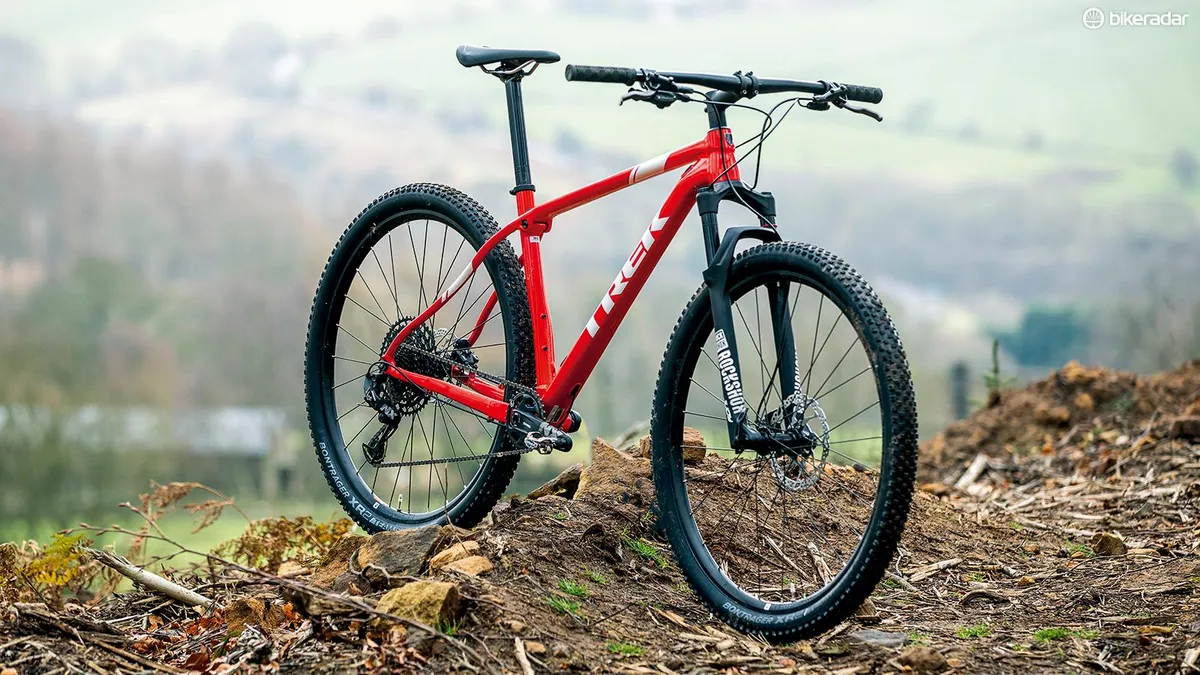Trek introduced its unique ‘IsoSpeed’ frame technology to its alloy MTBs last year, and the Procal 6 adds 12-speed SRAM Eagle shifting and RockShox’s impressive new Judy fork to the mix.
Trek Procaliber 6 frame
The IsoSpeed system uses a small pivot to ‘decouple’ the seat tube and top tube, allowing them to articulate back and forwards independently. The bottom of the dramatically offset asymmetric seat tube is also almost completely flattened to form a leaf spring segment, to help soften blows from the trail.
Other distinctive frame details include the ‘waist’ on the head tube and the extensively shaped and tapered top tube.
There’s a cable port for a Shimano side-swing front mech in case you want to swap the single chainring for a double, plus two mounting stubs that’ll also work for a chain guide.
A seat-tube exit hole and ‘spare’ internal down-tube routing allow you to upgrade to a stealth dropper, and the 31.6mm seat tube diameter gives you a full choice of posts, compared to the limited options available in 27.2mm.
You get mounts for two bottle-cages too. The rear stays have no braces, to give max mud clearance. They end at neat Boost-width dropouts for a through-axle (with a QR lever on the end, for tool-free wheel removal/insertion), with a brake mount that bridges between the stays.
Trek Procaliber 6 kit
Despite its complex frame and low price, the Procal 6 has a good spec. The Judy Gold is smooth, well-controlled and relatively light, thanks to its full-alloy construction.
It has a through-axle for accurate tracking and a shifter-style ‘OneLoc’ remote lockout. The only downside is the plastic ‘flag’ adjuster that makes rebound adjustment crude.
Drive is provided by a full SRAM NX Eagle set-up, with an oversized DUB axle rotating in broad-spaced press-fit bearings, which maximise stiffness but can be a pain to service.
The XG-1230 cassette is heavy in weight and feel compared to Shimano, but the shifting through the 11-50t gear range is simplicity itself and gives great drive efficiency.
Brakes are the basic but utterly dependable Shimano MT400s. The rest of the kit is Bontrager, including the distinctively backswept bar.
Trek Procaliber 6 ride

That bar makes a huge difference. By sweeping your hands further back, it mimics the effect of a shorter stem, so the 90mm unit feels more like 60-70mm.
As a result, the Trek feels twitchier and lighter, and there’s less weight on the front tyre. That’s compounded by an unusually slack seat tube, which also shifts your weight backward. This is handy for popping the wheel up over obstacles or off drops, but makes the front end more ‘fussy’ in terms of wandering about and losing the line, particularly on climbs.
As for the IsoSpeed system, it definitely, visibly works. If you hit a big lump, the seat tube bulges forward and the post sways back to help you ride out the blow. That’s useful if you get caught in the saddle by a big wallop, but most of the time you’ll be up and on the pedals anyway.
The shock-absorbing advantage while you’re powering a seated gear is also tempered by obvious rebound bounce, which can continue distractingly long after the initial impact. It takes a lot to get it moving too.
Bontrager’s X2 tyres are slower and less forgiving than their looks suggest — the ride was noticeably quicker and smoother when I swapped in the Chisel’s wheels.
The Trek still gets power down firmly though, without being as bruising as the Cube, and the accurate-tracking frame and quality fork mean you can drive the front end hard, once you’re used to the bar. Dropper compatibility and the ability to fit fatter tyres give the Procal 6 more aggressive-terrain potential too.

Trek Procaliber 6 specifications and geometry
- Sizes (*tested): 13.5, 15.5, 17.5, 18.5, 19.5*, 21.5, 23in
- Weight: 12.42kg
- Frame: ‘Alpha Platinum’ aluminium alloy
- Fork: RockShox Judy Gold RL Solo Air w/ OneLoc remote, 100mm (3.9in) travel
- Chainset: SRAM NX Eagle DUB, 30t
- Bottom bracket: SRAM DUB PF92
- Cassette: SRAM XG-1230, 11-50t
- Chain: SRAM NX Eagle
- Mech: SRAM NX Eagle
- Shifters: SRAM NX Eagle (1x12)
- Hubs: Bontrager
- Axles: 15x110 Boost (f), 12x148mm Boost (r)
- Rims: Bontrager Kovee
- Spokes: 28 stainless
- Tyres: Bontrager XR2 Team Issue 29x2.2in (54mm measured)
- Wheel weight: 1.97kg (f), 2.83kg (r), inc tyres
- Stem: Bontrager Elite, 90mm
- Bar: Bontrager Comp, 720mm
- Grips: Bontrager XR Trail Comp
- Headset: FSA IS-2
- Saddle: Bontrager Arvada
- Seatpost: Bontrager rigid
- Brakes: Shimano MT400, 180/160mm rotors
Trek Procaliber 6 geometry
- Seat angle: 72°
- Head angle: 69.5°
- Chainstay: 43.5cm / 17.13"
- Seat tube: 47cm / 18.5"
- Top tube: 64cm / 25.2"
- Head tube: 10cm / 3.94"
- Fork offset: 5.1cm / 2.01"
- Trail: 8.3cm / 3.27"
- Bottom-bracket drop: 5.8cm / 2.28"
- Bottom-bracket height: 31cm / 12.2"
- Wheelbase: 113cm / 44.49"
- Stack: 60.4cm / 23.78"
- Reach: 44cm / 17.32"

